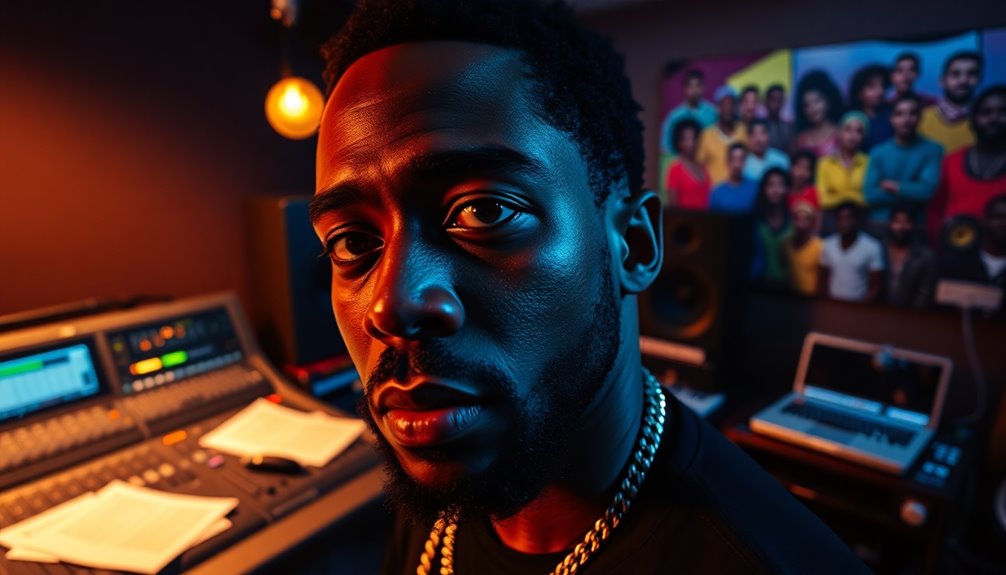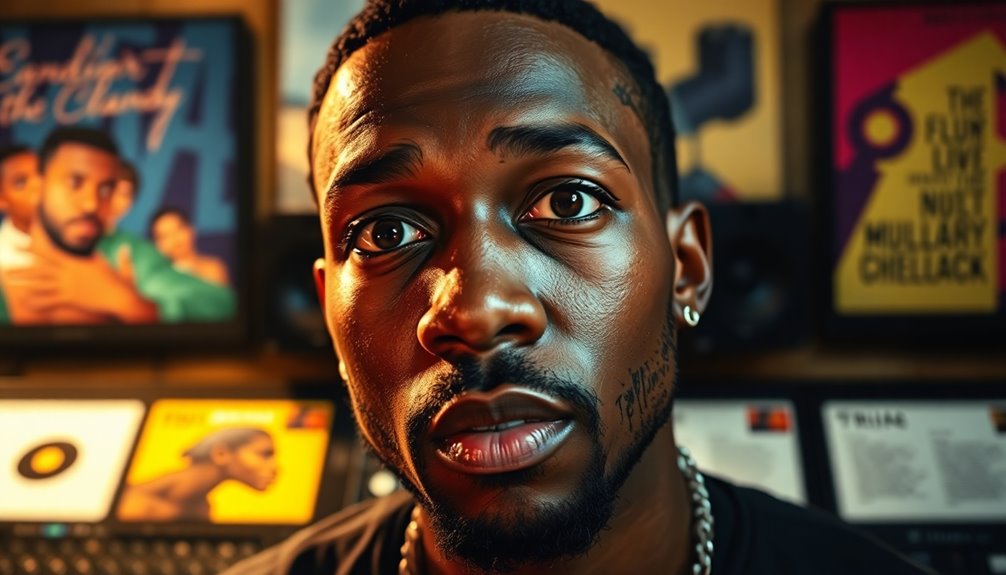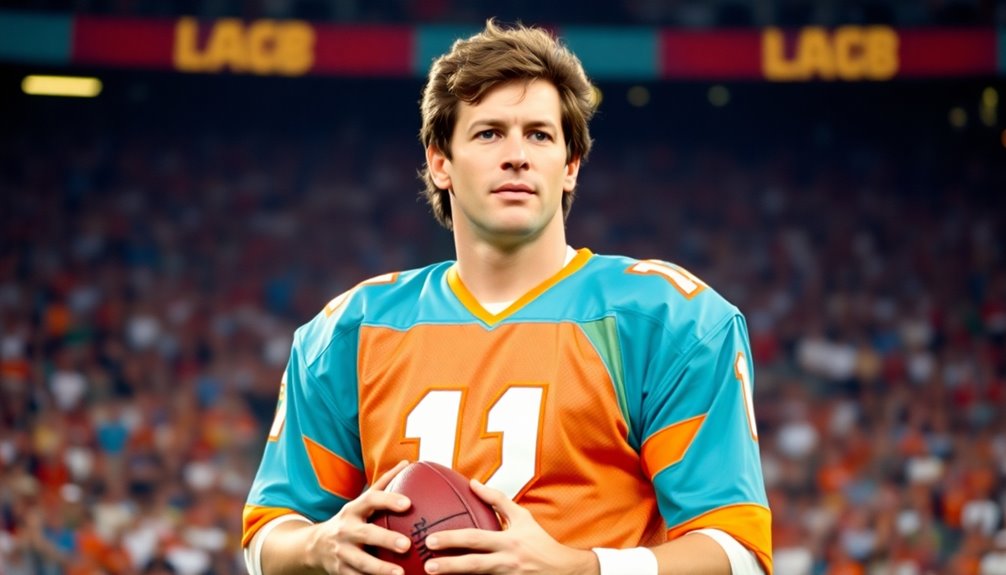Kendrick Lamar's life story is a powerful blend of struggle and triumph. Born in Compton, you see how early exposure to violence shaped his worldview. After releasing his first mixtape, he rose through the ranks, using music to tackle issues like race and identity. Each album tells a unique story, reflecting personal experiences and social justice. Tracks like "Alright" became anthems for movements, while his innovative approach has redefined hip-hop. With numerous awards, including a Pulitzer Prize, Kendrick's impact is undeniable. If you look closer, you'll uncover even more about his evolution and legacy in music.
Key Takeaways
- Kendrick Lamar's lyrics draw heavily from his traumatic childhood experiences, including witnessing violence and navigating socioeconomic challenges in Compton.
- His debut album, *good kid, m.A.A.d city*, reflects his personal struggles while addressing broader societal issues like race and identity.
- Songs like "Alright" and "The Blacker the Berry" serve as powerful anthems for social justice movements, resonating with audiences seeking change.
- Lamar's innovative storytelling, particularly in *To Pimp a Butterfly*, explores themes of identity, race, and personal struggle through a rich tapestry of lyrical depth.
- Recognized for his impactful lyrics, Lamar's work has earned him numerous accolades, including a Pulitzer Prize, cementing his legacy in music and culture.
Early Life and Influences

Growing up in Compton, California, Kendrick Lamar was shaped by a complex tapestry of influences and experiences. Born into a family with roots in Chicago, he faced socioeconomic challenges from an early age, living in Section 8 housing and relying on welfare. His father, a former gang hustler, exposed him to the harsh realities of gang culture and violence. You can imagine the impact of witnessing a murder at just five years old and experiencing the chaos of the 1992 Los Angeles riots.
Despite this tumultuous environment, Kendrick excelled academically, graduating high school with a 4.0 GPA. His seventh-grade teacher, Regis Inge, introduced him to poetry, which became an essential outlet for managing the psychological trauma he experienced. Writing offered him solace and a way to express the complexities of his life. In high school, he adopted the stage name K-Dot, which marked the beginning of his journey into music.
Though he had close ties to the Westside Pirus, Kendrick never joined a gang himself. Instead, he sought stability through education and spirituality, getting baptized at 16 after losing a friend. These experiences laid the foundation for his eventual journey into music, allowing him to channel his struggles into powerful narratives that resonate with many.
Beginnings in Music

Kendrick Lamar burst onto the music scene with a fierce determination to share his story. In 2003, he released his first mixtape, *Youngest Head Nigga in Charge*, under the name K. Dot. This project gained local attention, leading to a contract with Top Dawg Entertainment. You could see his raw talent shining through in his follow-up mixtapes, *Training Day* (2005) and *C4* (2009), which helped build his reputation in the underground rap scene.
In 2010, Kendrick dropped the K. Dot moniker and embraced his real name with the release of *Overly Dedicated*. This pivotal change reflected his personal growth and addressed complex themes like race and identity. It even made it onto Billboard's Top R&B/Hip-Hop Albums chart, catching the eye of Dr. Dre. Kendrick Lamar's music would later explore deep societal issues and earn him a Pulitzer Prize for music.
Kendrick collaborated with local artists, including Jay Rock and ScHoolboy Q, forming the hip-hop collective Black Hippy in 2008. Their joint efforts solidified his standing within the West Coast rap community. By July 2011, he released his debut studio album, *Section.80*, which explored deep societal issues and received critical acclaim.
| Year | Mixtape Title |
|---|---|
| 2003 | Youngest Head Nigga in Charge |
| 2005 | Training Day |
| 2009 | C4 |
| 2010 | Overly Dedicated |
| 2011 | Section.80
The Rise to Stardom

With the release of *Section.80* in 2011, Kendrick Lamar's journey took a significant turn, propelling him into the spotlight. This project showcased his lyrical prowess and deep understanding of social issues, resonating with listeners and critics alike. It wasn't just another album; it marked his emergence as a voice for a generation. Kendrick's first independent studio album captured the struggles and realities of his community, further cementing his relevance.
Here are three pivotal moments in Kendrick's rise to stardom:
- Co-sign from Legends: In 2011, hip-hop icons like Game, Snoop Dogg, and Dr. Dre hailed him as the "new king of the West Coast," elevating his status in the industry.
- Signing with Aftermath: In 2012, he signed with Dr. Dre's Aftermath Entertainment, a move that solidified his position among the elite in hip-hop.
- Grammy Recognition: Kendrick earned seven Grammy nominations for *good kid, m.A.A.d city*, further establishing him as a formidable talent and a critical darling.
These milestones laid a strong foundation for Kendrick's future success, shaping his identity as one of the most influential artists in modern music.
Breakthrough Albums

Since his emergence in the music scene, Kendrick Lamar has released several breakthrough albums that solidified his status as a transformative figure in hip-hop. His debut studio album, *Section .80*, dropped in 2011, peaking at 113 on the *Billboard* 200 despite minimal mainstream promotion. It addresses hard-hitting themes like the 1980s crack epidemic and showcases Kendrick's early mastery of storytelling. Kendrick is considered one of the most influential hip hop artists of his generation, which is evident through the impact of his work.
In October 2012, he released *Good Kid, M.A.A.D City*, marking his major-label debut under Aftermath Entertainment and Interscope Records. This conceptual album, framed as "a short film by Kendrick Lamar," explores his teenage years in Compton, delving into gang violence and community struggles.
Kendrick's 2015 album, *To Pimp A Butterfly*, became his first number-one album worldwide, receiving critical acclaim for its thematic depth and musical experimentation. It draws comparisons to classics like Marvin Gaye's *What's Going On*.
Lyrical Themes and Inspirations

Kendrick Lamar's lyrics often reflect his childhood experiences and the trauma that shaped him, providing a raw glimpse into his life. You'll find that he tackles social justice and activism head-on, using his platform to address pressing issues. His personal struggles and growth resonate deeply, showcasing a journey of healing and resilience that connects with listeners on multiple levels. This journey is beautifully illustrated in his collaboration with SZA on "Luther," where they explore the theme of emotional depth through their shared chemistry and lyrical narratives.
Childhood Experiences and Trauma
Growing up in Compton, Kendrick Lamar's childhood was shaped by the harsh realities of violence and instability. From witnessing a murder at just five years old to experiencing homelessness, his formative years were marked by trauma that deeply influenced his music. The environment he navigated inspired much of his lyrical content, allowing you to see the raw emotions that stem from his experiences.
Here are three key aspects of Kendrick's childhood that resonate in his lyrics:
- Witnessing Violence: The early exposure to gang violence and police brutality left a lasting impact, instilling feelings of fear and confusion that he channels into powerful storytelling.
- Family Dynamics: With a father involved in gangs and a mother working tirelessly as a hairdresser, Kendrick reflects on the struggles of his family life, illustrating the complexities of love and survival, which is echoed in his song "The Art of Peer Pressure" that highlights the pressures of his upbringing.
- Educational Influences: Encouraged to write from a young age, Kendrick used poetry as an outlet for his pain, shaping his path toward music and lyrical expression.
These childhood experiences resonate throughout his discography, providing listeners with a glimpse into the mind of an artist molded by adversity.
Social Justice and Activism
Social justice and activism are at the heart of Kendrick Lamar's music, reflecting the struggles and triumphs of marginalized communities. You can hear this commitment in songs like "Alright," which became a rallying cry during Black Lives Matter protests. Its empowering chorus, "We gon' be alright," provided hope and unity amidst social unrest following tragic events like the deaths of Eric Garner and Michael Brown.
Lamar tackles systemic inequalities head-on in tracks like "The Blacker the Berry" and "DNA," addressing racism, discrimination, and economic injustice. His latest album, *Mr. Morale & The Big Steppers*, even dives into topics surrounding gender and sexuality, advocating for the acceptance of the LGBTQ community. Inspired by reggae legends, Lamar's music resonates globally, as seen when he performed "Alright" at the Move Afrika event in Rwanda. Music as a universal language for justice allows Lamar's messages to reach diverse audiences, emphasizing the global nature of social justice movements.
His work has garnered significant recognition, including a Pulitzer Prize for *DAMN.*, highlighting the relevance of his lyrics on societal issues. Through collaborations with artists like Beyoncé and sharp social commentary, Lamar continues to inspire conversations about justice, unity, and the need for change in today's world.
Personal Struggles and Growth
From the very start of his career, Kendrick Lamar's lyrics have been a powerful reflection of his personal struggles and growth. Growing up in Compton, he faced violence and socioeconomic challenges that shaped his worldview. His music serves as a cathartic outlet, addressing themes of mental health, self-discovery, and resilience.
Here are three key aspects of Kendrick's journey:
- Mental Health Awareness: Kendrick openly discusses his battle with depression, particularly in tracks like "u," emphasizing the importance of addressing mental health seriously.
- Transformative Experiences: Fatherhood profoundly impacts his perspective, allowing him to explore themes of unconditional love and personal integrity in his work. This journey of growth is further highlighted in *Mr. Morale & the Big Steppers*, which represents a culmination of his personal and artistic growth.
- Creative Catharsis: Albums like *good kid, m.A.A.d city* and *To Pimp a Butterfly* detail his life experiences, serving as a blueprint for future generations on how to navigate life's challenges.
Through his music, Kendrick continually evolves, proving he's not the same person he was yesterday. His ability to confront and express complex emotions makes his artistry not just relatable, but also deeply impactful.
Awards and Honors

Kendrick Lamar's impressive collection of awards and honors reflects his profound impact on the music industry. With 17 Grammy Awards to his name, he's made history as one of the most celebrated artists in the genre. His album *DAMN.* even earned him the prestigious 2018 Pulitzer Prize for Music, a first for a hip-hop artist. In 2022, he added a Primetime Emmy Award for Outstanding Variety Special (Live) to his accolades, showcasing his versatility beyond music. Additionally, his Grammy wins for Best Rap Album highlight his critical acclaim and commercial success.
Kendrick's Grammy nominations total an astounding 47, with multiple wins for Best Rap Album for *To Pimp a Butterfly*, *DAMN.*, and *Mr. Morale & the Big Steppers*. He's also clinched the Best Rap Performance award four times. His impact extends to other platforms, being the most awarded artist in BET Hip Hop Awards history with 37 wins and securing 11 MTV Video Music Awards.
In addition to his Grammy success, Kendrick's nominations for prestigious awards like the Academy Award for Best Original Song and Golden Globe for "All the Stars" highlight his influence across various mediums, solidifying his status as a true icon. This is further evidenced by his collaboration on "HUMBLE.," which won Grammy Awards for Best Rap Performance and Best Music Video, showcasing his ability to create award-winning songs.
Collaborations and Features

Kendrick Lamar's collaborations and features showcase his versatility and impact on hip-hop. You'll notice his ability to elevate tracks with powerful guest verses, whether it's on a Big Sean song or a track by DJ Khaled. Each collaboration reflects not just his talent, but also his influence across various genres and artists. Notably, his verse on Control instilled fear in his peers and set a new standard for lyrical competition in hip-hop.
Notable Collaborations Overview
Throughout his career, Kendrick Lamar has forged remarkable collaborations that showcase his versatility and artistry. These partnerships span genres and demonstrate his ability to blend seamlessly with other artists, creating unforgettable music moments. Here are three standout collaborations that highlight his range:
- Taylor Swift – Kendrick featured on "Bad Blood," a massive hit from Swift's 2014 album 1989 which topped charts worldwide.
- Jay Rock – On "King's Dead," from the Black Panther OST Kendrick united with Jay Rock, Future, and James Blake to deliver a powerful anthem, further emphasizing his role in Black Panther's soundtrack.
- Sia – His collaboration on "The Greatest" from Sia's This Is Acting serves as a poignant response to the tragic Orlando Pulse nightclub shootings.
These collaborations reflect not just Kendrick's lyrical prowess but also his ability to connect with diverse artists, from pop icons to fellow rappers. Each partnership adds another layer to his artistic identity, making him a pivotal figure in contemporary music. Whether in soundtracks or mainstream hits, Kendrick proves time and again that he can elevate any project he's part of.
Impactful Guest Verses
Here's a look at some impactful guest verses by Kendrick:
| Track | Artist | Notable Elements |
|---|---|---|
| "Deep Water" | Dr. Dre | Nautical motifs and subtle shots at Drake |
| "No More Parties in LA" | Kanye West | Laid-back storytelling with sharp lyricism |
| "Holy Key" | DJ Khaled | Deep content amidst a star-studded tracklist |
| "Family Ties" | Baby Keem | Blending goofiness with determination |
From collaborations with top artists to genre-bending features, Kendrick's contributions often elevate the entire project. His verses provide depth, provoke thought, and offer a contrasting perspective, making each collaboration a significant event in hip-hop. Whether it's with labelmates or on high-profile tracks, Kendrick's impact resonates long after the music stops.
Influence on Hip-Hop
Collaborating with a diverse array of artists, Kendrick Lamar has greatly influenced hip-hop through his features and partnerships. His ability to blend genres and connect with top talents has not only expanded his reach but also redefined what it means to be an artist in this space. Here are three standout collaborations that showcase his impact:
- Dr. Dre's "Deep Water" – Featured on this track from the Compton album, Kendrick solidified his place in hip-hop history alongside a legend.
- Kanye West's "No More Parties in L.A." – This collaboration highlighted Kendrick's lyrical prowess and versatility, attracting attention from both hip-hop and pop audiences.
- Taylor Swift's "Bad Blood" – By joining forces with Swift, Kendrick crossed into mainstream pop, exposing his artistry to a broader audience.
These collaborations illustrate how Kendrick not only enhances the tracks he features on but also pushes the boundaries of hip-hop. His work with artists like Anderson .Paak and Vince Staples further exemplifies his commitment to innovation and collaboration in music. Additionally, his guest verses often lead to standout tracks and viral moments, showcasing his ability to overshadow original artists.
Recent Projects and Innovations

Kendrick Lamar continues to push boundaries with his recent projects and innovations, most notably the surprise album *GNX*, released on November 22, 2024. This album emerged in the wake of a public feud with Drake, highlighted by the track "Not Like Us." Collaborating with longtime producer Sounwave and Jack Antonoff, Kendrick crafted an eclectic sound that showcases his versatility. The album cover features a Buick, which you might recognize from a video Kendrick shared, adding a visual element to his artistic narrative. Buick also featured in the album artwork adds a distinct layer to the overall aesthetic of the project.
Following the release of *GNX*, Kendrick's buzz only grows as he's set to headline the halftime show at the Super Bowl in February 2025 in New Orleans. This high-profile performance will likely blend new tracks from *GNX* with his classic hits, enchanting fans and critics alike.
The surprise release generated considerable media attention and public interest, especially after the recent feud that heightened anticipation. Early reviews praise the album's themes and lyrical depth, confirming Kendrick's ongoing critical acclaim and solidifying his influence within the music industry. As he continues to innovate, the excitement surrounding his work remains palpable.
Legacy and Impact

With a rich catalog and a string of groundbreaking projects, Kendrick Lamar's legacy and impact on the music industry are undeniable. He's not just an artist; he's a cultural force who's shaped the genre in profound ways. Here are three key aspects of his legacy:
- Critical Acclaim: Kendrick made history by winning the Pulitzer Prize for Music in 2018 for *DAMN.*, becoming the first non-classical or jazz artist to achieve this honor. His albums consistently earn Grammy nominations, highlighting his artistic excellence. In addition to this, his album *To Pimp a Butterfly* is recognized for its innovative approach to storytelling.
- Influence on Hip-Hop: As a key figure in the hip-hop supergroup Black Hippy, he's collaborated with industry giants like Beyoncé and Taylor Swift. Kendrick's fusion of jazz, funk, and soul into hip-hop has inspired a new generation of artists.
- Cultural Impact: His music tackles pressing social issues such as racism and addiction, reflecting his upbringing in Compton. Kendrick's work, including the *Black Panther* soundtrack, resonates with audiences, showcasing the power of music as a vehicle for change.
Kendrick Lamar's contributions will resonate for years to come, influencing artists and fans alike.
Frequently Asked Questions
What Unique Writing Techniques Does Kendrick Lamar Use in His Lyrics?
Like a painter mixing colors, you'll find Kendrick blends raw emotions with vivid imagery in his lyrics. He uses personal experiences, meticulous beat selection, and an experimental mindset to create authentic, resonant storytelling that captivates listeners.
How Has Kendrick Lamar's Upbringing Influenced His Music Style?
Kendrick's upbringing in Compton shapes your understanding of his music. His experiences with violence, poverty, and resilience infuse his lyrics with authenticity, allowing you to connect deeply with themes of struggle, identity, and hope.
What Are Some Lesser-Known Facts About Kendrick Lamar's Personal Life?
You might not know Kendrick's got a deep bond with his high school sweetheart, Whitney. He values calling her his best friend, and his love for sugary cereals like Fruity Pebbles adds a personal touch to his life.
How Does Kendrick Lamar Approach Songwriting for Different Projects?
You'll find Kendrick Lamar approaches songwriting by channeling his emotions and experiences. He collaborates with producers aligning with his vision, often blending various musical styles and themes to create impactful, layered narratives in each project.
What Impact Has Kendrick Lamar Had on Contemporary Hip-Hop Culture?
Kendrick Lamar's impact on contemporary hip-hop culture's profound. You see him challenging materialism, inspiring social change, and pushing for deeper artistic integrity, encouraging you to seek meaningful content amidst the superficiality dominating today's music landscape.









